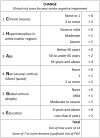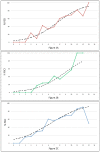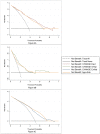Development and validation of a risk score (CHANGE) for cognitive impairment after ischemic stroke
- PMID: 28963553
- PMCID: PMC5622067
- DOI: 10.1038/s41598-017-12755-z
Development and validation of a risk score (CHANGE) for cognitive impairment after ischemic stroke
Abstract
Post-stroke cognitive impairment (PSCI) warrants early detection and management. We sought to develop a risk score for screening patients at bedside for risk of delayed PSCI. Ischemic stroke survivors with PSCI and no cognitive impairments (NCI) 3-6 months post-stroke were studied to identify candidate variables predictive of PSCI. These variables were used to develop a risk score using regression models. The score, and the best identified clinical cutoff point, underwent development, stability testing, and internal and external validation in three independent cohorts from Singapore and Hong Kong. Across 1,088 subjects, the risk score, dubbed CHANGE, had areas under the receiver operating characteristics curve (AUROC) from 0.74 to 0.82 in detecting significant risk for PSCI, and had predicted values following actual prevalence. In validation data 3-6 and 12-18 months post-stroke, subjects with low, medium, and high scores had PSCI prevalence of 7-23%, 25-58%, and 67-82%. CHANGE was effective in screening ischemic stroke survivors for significant risk of developing PSCI up to 18 months post-stroke. CHANGE used readily available and reliable clinical data, and may be useful in identifying at-risk patients for PSCI.
Conflict of interest statement
The authors declare that they have no competing interests.
Figures



Similar articles
-
Predictors of Cognitive Impairment After Stroke: A Prospective Stroke Cohort Study.J Alzheimers Dis. 2019;71(4):1139-1151. doi: 10.3233/JAD-190382. J Alzheimers Dis. 2019. PMID: 31524163
-
Strategic infarct locations for post-stroke cognitive impairment: a pooled analysis of individual patient data from 12 acute ischaemic stroke cohorts.Lancet Neurol. 2021 Jun;20(6):448-459. doi: 10.1016/S1474-4422(21)00060-0. Epub 2021 Apr 23. Lancet Neurol. 2021. PMID: 33901427
-
Cognitive Impairment after Mild Stroke: Development and Validation of the SIGNAL2 Risk Score.J Alzheimers Dis. 2016;49(4):1169-77. doi: 10.3233/JAD-150736. J Alzheimers Dis. 2016. PMID: 26599056
-
Post-Stroke Cognitive Impairment: A Narrative Review of the Comprehensive Screening and Detecting Process.J Gerontol Nurs. 2025 Mar;51(3):19-27. doi: 10.3928/00989134-20250212-03. Epub 2025 Mar 1. J Gerontol Nurs. 2025. PMID: 40014414 Review.
-
Blood biomarkers for post-stroke cognitive impairment: A systematic review and meta-analysis.J Stroke Cerebrovasc Dis. 2024 Aug;33(8):107632. doi: 10.1016/j.jstrokecerebrovasdis.2024.107632. Epub 2024 Feb 28. J Stroke Cerebrovasc Dis. 2024. PMID: 38417566
Cited by
-
Machine learning-based predictive model for post-stroke dementia.BMC Med Inform Decis Mak. 2024 Nov 11;24(1):334. doi: 10.1186/s12911-024-02752-4. BMC Med Inform Decis Mak. 2024. PMID: 39529118 Free PMC article.
-
Development and Validation of a Clinical Model (SHACEA) for Post-stroke Cognitive Impairment Prognosis Occurred at Acute Phase and Last to 6 Months.Mol Neurobiol. 2025 Jul;62(7):8475-8483. doi: 10.1007/s12035-025-04783-y. Epub 2025 Feb 26. Mol Neurobiol. 2025. PMID: 40009260
-
Predicting cognitive decline in cognitively impaired patients with ischemic stroke with high risk of cerebral hemorrhage: a machine learning approach.Front Neurol. 2025 Jul 25;16:1569073. doi: 10.3389/fneur.2025.1569073. eCollection 2025. Front Neurol. 2025. PMID: 40786624 Free PMC article.
-
Prediction of post-stroke cognitive impairment after acute ischemic stroke using machine learning.Alzheimers Res Ther. 2023 Aug 31;15(1):147. doi: 10.1186/s13195-023-01289-4. Alzheimers Res Ther. 2023. PMID: 37653560 Free PMC article.
-
Neuroimaging biomarkers of cognitive recovery after ischemic stroke.Front Neurol. 2022 Dec 14;13:923942. doi: 10.3389/fneur.2022.923942. eCollection 2022. Front Neurol. 2022. PMID: 36588894 Free PMC article. Review.
References
Publication types
MeSH terms
Substances
LinkOut - more resources
Full Text Sources
Other Literature Sources
Medical

